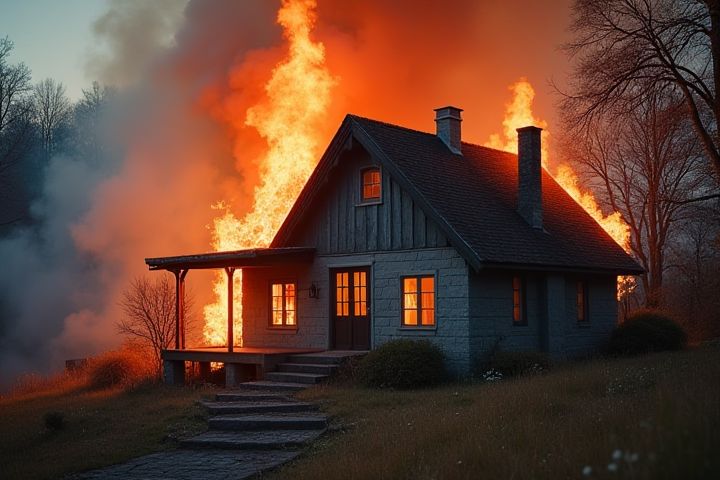
A fireproof house typically features materials and construction techniques designed to resist fire damage. This includes using non-combustible materials such as brick, concrete, and metal for exterior walls and roofing. Insulation and windows made from fire-resistant glass also enhance fire safety. Landscaping plays a crucial role, with defensible space around the home achieved through strategically placed vegetation and firebreaks. Incorporating fire-resistant coatings and regularly maintaining gutters and eaves can further protect your home from potential fire hazards.
Can A House Be Fireproof
Fire-resistant materials
A house can be made more fire-resistant by utilizing fire-resistant materials such as brick, stone, and concrete for exterior walls, which can withstand high temperatures. Roofing materials like metal and slate are also effective in preventing fire ignition, with the potential to lower fire insurance costs by up to 30%. Furthermore, installing tempered glass windows can significantly enhance the home's fire resilience, as they can endure extreme heat. Incorporating non-combustible decking and fire-rated doors can create a protective barrier, making your property safer in the event of a wildfire or accidental fire.
Building codes and regulations
Building codes and regulations often stipulate the use of fire-resistant materials in construction to enhance a house's fire safety. Fireproofing techniques may include using non-combustible materials for roofing, siding, and insulation, as well as incorporating fire-rated doors and windows. Local regulations may prescribe specific fire safety standards, such as maintaining defensible space around the property and installing fire sprinklers in high-risk areas. While no house can be entirely fireproof, adhering to these codes significantly reduces the risk of fire damage and increases safety for occupants.
Fireproof coatings
Fireproof coatings are an effective way to enhance the fire resistance of a house, protecting it from flames and heat. These specialized coatings, often made from intumescent materials, expand when exposed to high temperatures, creating a protective layer that insulates the underlying surfaces. Homes treated with fireproof coatings can significantly reduce their vulnerability to wildfires, especially in areas prone to such risks, where temperatures can exceed 1,000 degrees Fahrenheit. By investing in fireproof coatings, you can enhance the overall safety and longevity of your property, potentially saving on costly repairs and providing peace of mind.
Fire-retardant treatments
A house cannot be entirely fireproof, but it can be made significantly more resistant to fire through various fire-retardant treatments. Applying fire-resistant coatings to wooden structures helps delay ignition and reduces the spread of flames. Using fire-retardant materials for roof shingles, siding, and insulation can further enhance your home's safety, minimizing potential damage during a fire. Regularly upgrading these treatments can improve your home's resilience against wildfires and other fire-related incidents.
Fire-resistant windows and doors
Fire-resistant windows and doors play a crucial role in enhancing a house's fireproof capabilities. These components, often made from tempered glass or double-glazed systems, provide increased resistance to high temperatures and prevent flames from entering or spreading within the home. When selecting fire-resistant materials, look for products with a specific fire rating, which indicates their ability to withstand heat for a certain duration. By incorporating these elements into your home's design, you significantly improve its overall fire safety and protect your living space from potential fire damage.
Defensible space landscaping
A fireproof house can be significantly enhanced by implementing defensible space landscaping, which creates a buffer between the structure and potential wildfires. This approach typically involves maintaining a minimum of 30 feet of cleared vegetation around the home, utilizing fire-resistant plants, and regularly trimming trees and shrubs to reduce fuel load. For optimal protection, you can incorporate hardscaping materials like gravel or stone, which serve as effective barriers against fire spread. Studies show that homes surrounded by well-maintained defensible spaces have a higher survival rate during wildfires, emphasizing the importance of conscious landscaping in fire prevention.
Sprinkler systems
A house cannot be entirely fireproof, but implementing a high-quality sprinkler system significantly enhances fire safety. Automatic sprinkler systems identify heat from flames and discharge water to suppress the fire, potentially reducing damage and saving lives. These systems can decrease the intensity of a blaze before firefighters arrive, providing crucial time for evacuation and minimizing property loss. Investing in a reliable sprinkler system is a proactive step in safeguarding your home and ensuring the safety of its occupants.
Non-combustible roofing materials
Fireproofing a house involves selecting non-combustible roofing materials, which significantly enhance fire resistance. Materials like metal, clay tiles, and concrete are ideal choices due to their ability to withstand high temperatures and resist ignition. Using these roofing options not only protects your home from potential fire threats but can also lower homeowners' insurance premiums in fire-prone areas. Investing in non-combustible materials contributes to the overall safety and longevity of your residence.
Ember-resistant vents
Ember-resistant vents play a crucial role in enhancing a house's fireproofing capabilities, especially in wildfire-prone areas. Constructed from materials designed to withstand high heat, these vents prevent embers from infiltrating the home, which can ignite combustible materials inside. Homes equipped with ember-resistant vents significantly lower the risk of fire damage, making them a wise investment for homeowners in at-risk regions. By utilizing such protective features, you can substantially improve your property's resilience against wildfires.
Regular maintenance and inspections
A fireproof house typically involves a combination of fire-resistant materials and regular maintenance practices. Ensuring that your home has fire-retardant siding, roofing, and insulation can significantly reduce fire risk. Regular inspections, at least once a year, of key areas such as electrical systems, plumbing, and potential fuel sources like stored chemicals are essential for early detection of hazards. Keeping gutters clear of debris and ensuring proper landscaping can also play a crucial role in fire prevention strategies.
